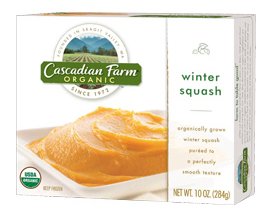Winter Squash Wow!
Nutrients in Winter Squash
Winter squash is loaded with fiber, vitamins, minerals, phytonutrients and antioxidants, yet low in calories. Winter squash provides almost 6 grams of fiber per cup! Its beautiful orange color reflects its most well-known trait: an abundance of powerhouse nutrients known as carotenoids. Winter squash turns out to be the best primary food source of alpha-carotene and beta-carotene! It is especially high in beta-carotene, which the body converts to vitamin A. Roasted butternut squash provides almost 500 times the percent Daily Value of Vitamin A recommended for a 2000 calorie diet.
Vitamin A functions as an antioxidant to fight cancer by decreasing the levels of free radicals roaming the body. These free radicals damage neighboring molecules, which in turn cause a chain reaction very quickly. Eventually, this can stress a cell enough to cause it to become cancerous. With lots of antioxidants in our system, free radicals can be suppressed before they have the chance to do much damage. Vitamin A also protects against heart disease and eye damage, and supports the immune system and skin health.
Several studies show that winter squash is among the top three food sources for lutein, zeaxanthin, and beta-cryptoxanthin, three other health-supportive carotenoids. What's more, with only a 1-cup serving of butternut squash, for instance, you get nearly half of the recommended daily dose of vitamin C and an excellent dose of manganese and potassium as well. Butternut squash is high in thiamin, niacin, calcium and magnesium, as well as vitamins B6 and E.
Although the starches in winter squash are primarily carbohydrates, research has shown that, in addition to their high levels of fiber, these starches are beneficial because of their specially-structured polysaccharides, called homogalacturonan. They have even more antioxidant, anti-inflammatory, and insulin-regulating properties.
Another important nutrient of squash has been discovered only recently. Squash is known to contain coumarins that can potentially have blood-thinning effects, which may be beneficial for those with poor circulation and heart disease.Unfortunately, winter squash is efficient at mobilizing contaminants like PAHs from the soil. For this reason, you may want to purchase organic winter squash.Roasting and steaming winter squash are the best cooking methods for enhancing and retaining their valuable nutrients. Roasting the squash develops the flavor and gives it a richer, caramelized taste. It's easy to cut the squash in half and place it cut-side down on a pan drizzled with olive oil, and then bake at 375 degrees for an hour or so.
Easy ways to prepare and eat squash
Cutting a winter squash's thick skin can be daunting, but piercing the squash and placing it in the microwave for 2-3 minutes will soften it and make it easier to cut and peel. Unlike the other varieties of winter squash, a butternut squash's rind is thin enough to peel off with a vegetable peeler, and easy to peel off once cooked. Steaming is faster than roasting and can be done in the microwave, as well as the stovetop. Given the acorn squash's small size, kids can enjoy it cut in half and cooked and served in its own shell. The first time you serve it to them, have them help you buy it and watch you cut it and put it in the oven. Add some butter and salt and possibly a little brown sugar prior to roasting if you think that will hook them. As time goes on, cut back on the butter and sugar because their first impression will enable them to have an "I love this" mind set in the future.For faster, more convenient ways to use winter squash in your cooking, buy fresh, cubed squash from your produce department or Costco. It's also sold already cubed or pureed in your freezer section as well.
Try making my Squash Corn Bread and serving it with this easy Roasted Butternut Soup made with roasted apples. Everyone will enjoy Black Bean and Butternut Squash Tacos, and you can't go wrong with my variation of Rachel Ray's, Butternut Squash Mac and Cheese. No one can tell that it has squash in it, and the flavor is terrific! The kids to whom I've given it always ask for more. Spaghetti squash roasted with fresh Romano cheese alone or with marinara sauce is always a winner, especially with the calorie-conscious. This Thanksgiving, serve Ina Garten's, Maple-Roasted Butternut Squash baked with a little bit of real maple syrup and olive oil for something new and delicious.
Join the November 2011 Healthy Challenge and eat lots of winter squash. Enjoy and be healthier! SaveSave




